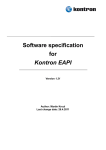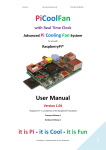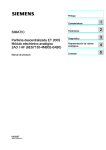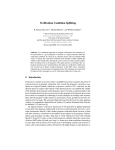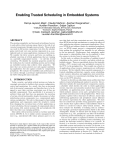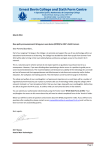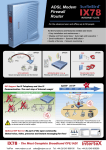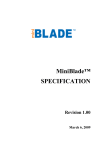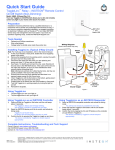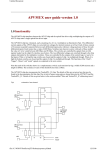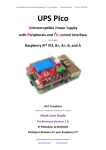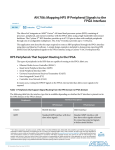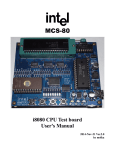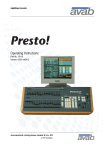Download Industry Standard Control Interfaces for inter IC Communication
Transcript
Industry Standard Control Interfaces for inter IC Communication Moritz Nöltner Institut für Technische Informatik Lehrstuhl für Rechnerarchitektur Universität Heidelberg January 28, 2015 Introduction SPI I2 C Measurements Conclusion Table of Contents 1 Introduction 2 Serial Peripheral Interface 3 Inter-Integrated Circuit 4 Practical Part 5 Conclusion Moritz Nöltner 2 / 35 Introduction SPI I2 C Measurements Conclusion Table of Contents 1 Introduction 2 Serial Peripheral Interface 3 Inter-Integrated Circuit 4 Practical Part 5 Conclusion Moritz Nöltner 3 / 35 Introduction SPI I2 C Measurements Conclusion How to Connect Circuits? Device 1 ?? Device 2 HyperTransport CAN PATA, SATA UART, USART PCI, PCI-Express SPI AGP I2 C, SMBus ISA UNI/O USB 1-Wire Moritz Nöltner 4 / 35 Introduction SPI I2 C Measurements Conclusion Speed <=> Simplicity Source: http://www.anandtech.com/show/2354/2 Moritz Nöltner 5 / 35 Introduction SPI I2 C Measurements Conclusion Table of Contents 1 Introduction 2 Serial Peripheral Interface 3 Inter-Integrated Circuit 4 Practical Part 5 Conclusion Moritz Nöltner 6 / 35 Introduction SPI I2 C Measurements Conclusion Serial Peripheral Interface Created in the 1980s First used in Motorola 6800 Very widely accepted Bus system Full duplex Source: http://en.wikipedia.org/wiki/File: Motorola_MC6800_microprocessor.jpg Moritz Nöltner Four signal lines typically 7 / 35 Introduction SPI I2 C Measurements Conclusion SPI Signal Lines Source: Adapted from ``SPI Block Guide V 03.06'', 2003 Moritz Nöltner 8 / 35 Introduction SPI I2 C Measurements Conclusion SPI Signal Lines Source: Adapted from ``SPI Block Guide V 03.06'', 2003 • SS Slave Select Slaves will only interact if their SS is acrive Moritz Nöltner 8 / 35 Introduction SPI I2 C Measurements Conclusion SPI Signal Lines Source: Adapted from ``SPI Block Guide V 03.06'', 2003 • MOSI Master Out, Slave In Serial data line for master to slave Moritz Nöltner 8 / 35 Introduction SPI I2 C Measurements Conclusion SPI Signal Lines Source: Adapted from ``SPI Block Guide V 03.06'', 2003 • MISO Master In, Slave Out Serial data line for master to slave Moritz Nöltner 8 / 35 Introduction SPI I2 C Measurements Conclusion SPI Signal Lines Source: Adapted from ``SPI Block Guide V 03.06'', 2003 • CLOCK Shift Clock One bit is sent per clock cycle Moritz Nöltner 8 / 35 Introduction SPI I2 C Measurements Conclusion Clock Phase & Polarity 4 combinations: Source: Taken from the datasheet for Motorola MC68HC11A0 Moritz Nöltner 9 / 35 Introduction SPI I2 C Measurements Conclusion SPI Bus Topologies: Star 3+n signal lines MOSI, MISO, CLOCK shared One SS for every slave Master activates a slave and communicates with it No delay Source: Adapted from http://en.wikipedia.org/wiki/File: SPI_three_slaves.svg Moritz Nöltner 10 / 35 Introduction SPI I2 C Measurements Conclusion SPI Bus Topologies: Serial Four signal lines MOSI, MISO, CLOCK, SS shared Messages are passed through Messages get latched, when SS is deasserted Not supported by all devices Source: Adapted from http://en.wikipedia.org/wiki/File: SPI_three_slaves_daisy_chained.svg Moritz Nöltner Delayed responses, message has to pass adjacent slaves 11 / 35 Introduction SPI I2 C Measurements Conclusion Table of Contents 1 Introduction 2 Serial Peripheral Interface 3 Inter-Integrated Circuit 4 Practical Part 5 Conclusion Moritz Nöltner 12 / 35 Introduction SPI I2 C Measurements Conclusion Inter-Integrated Circuit Created in the 1980s First used in Philips MAB8400B Very widely accepted Compatible with other buses: SMBus, PMBus Bus system Source: http://www.cpushack.com/gallery-1/philips/philipsmab8400b Multi-master operation Half duplex (simplex) Two signal lines + two pull-up resistors Moritz Nöltner 13 / 35 2 Introduction SPI I2 C Measurements Conclusion I C Roles Four roles possible: •Master •Slave •Transmitter •Receiver Starts a transmission Responds to transmission Transmits data Receives data Moritz Nöltner 14 / 35 2 Introduction SPI I2 C Measurements Conclusion I C Signal Lines Source: Adapted from ``The I2 C-Bus Specification v. 2.1'', 2000 Moritz Nöltner 15 / 35 2 Introduction SPI I2 C Measurements Conclusion I C Signal Lines Source: Adapted from ``The I2 C-Bus Specification v. 2.1'', 2000 •SDA Seria Data Bidirectional data– & address line Moritz Nöltner 15 / 35 2 Introduction SPI I2 C Measurements Conclusion I C Signal Lines Source: Adapted from ``The I2 C-Bus Specification v. 2.1'', 2000 •SCL Serial Clock Used by the master to synchronise with the slaves Moritz Nöltner 15 / 35 2 Introduction SPI I2 C Measurements Conclusion I C Electrical Setup Open-drain or open-collector outputs Wired-AND Source: Adapted from ``The I2 C-Bus Specification v. 2.1'', 2000 Moritz Nöltner 16 / 35 2 Introduction SPI I2 C Measurements Conclusion I C Protocol Parts Start Address R/W ACK Moritz Nöltner Stop Data NACK 17 / 35 2 Introduction SPI I2 C Measurements Conclusion I C Protocol Parts Start R/W Address Stop Data ACK NACK • SCL high • Master injects negative Edge on SDA Moritz Nöltner 17 / 35 2 Introduction SPI I2 C Measurements Conclusion I C Protocol Parts Start R/W Address Stop Data ACK NACK • Seven bits of address are transmitted • Some addresses are reserved Moritz Nöltner 17 / 35 2 Introduction SPI I2 C Measurements Conclusion I C Protocol Parts Start R/W Address Stop Data ACK NACK • “1” for reading • “0” for writing Moritz Nöltner 17 / 35 2 Introduction SPI I2 C Measurements Conclusion I C Protocol Parts Start R/W Address Stop Data ACK NACK • Transmitter releases the SDA line • Receiver pulls SDA low to acknowledge Moritz Nöltner 17 / 35 2 Introduction SPI I2 C Measurements Conclusion I C Protocol Parts Start R/W Address Stop Data ACK NACK • Transmitter sends one byte of data • It may send the next byte if receiver acknowledges • When receiver notacknowledges the transmission ends Moritz Nöltner 17 / 35 2 Introduction SPI I2 C Measurements Conclusion I C Protocol Parts Start R/W Address Stop Data ACK NACK • SCL high • Master injects Positive-going Edge on SDA Moritz Nöltner 17 / 35 2 Introduction SPI I2 C Measurements Conclusion I C Protocol Example/1 Simple I2 C read on default register Moritz Nöltner 18 / 35 2 Introduction SPI I2 C Measurements Conclusion I C Protocol Example/2 Example of repeated start Example of multi-byte transmission Moritz Nöltner 19 / 35 2 Introduction SPI I2 C Measurements Conclusion I C Clock Stretching • No fixed speed: Any device may slow down the transmission • Master pauses switching of SCL →transmission is paused • Slave holds SCL low →master waits for release Upper diagram: noNöltner stretching, lower diagram: with stretching Moritz 20 / 35 2 Introduction SPI I2 C Measurements Conclusion I C Collision Detection & Bus Arbitration • • • • • Two devices issue start condition →become master of the bus Both transmit address and possibly data One master sends “1”, one sends “0” The master sending “1” notices the discrepancy between its output a A master that lost bus arbitration switches to slave mode • Second master became slave before any race condition occured • →no data loss Moritz Nöltner 21 / 35 2 Introduction SPI I2 C Measurements Conclusion I C 10-bit Addressing • 7-bit addressing means 128 addresses • 16 addresses reserved →only 112 addresses free • More addresses needed →10-bit-addressing: First byte: 11110 + first 2 bits of 10-bit address + R/W-bit Second byte: Remaining 8 bits of slave address Rest of transmission as usual Source: Adapted from ``UM10204I2C-busspecificationandusermanualRev.6'',2014 Moritz Nöltner 22 / 35 2 Introduction SPI I2 C Measurements Conclusion I C Higher Speeds • Standard Mode • Fast Mode • Fast Mode Plus • High Mode Speed Up to 100kbit/s Up to 400kbit/s Fully compatible with Standard Mode Up to 1Mbit/s Timing loosened, more drive strength Up to 3.4Mbit/s A number of changes: ∘ Pull-up current sources in each device ∘ Schmitt-trigger inputs for spike suppression ∘ Clock stretching only after ACK bit ∘ →special initiation: master-code “00001XX” “X” transmitted in Fast Mode Bus arbitration only during master-code transfer Moritz Nöltner 23 / 35 2 Introduction SPI I2 C Measurements Conclusion I C High Speed Mode Electrical Setup Source: Adapted from ``The I2 C-Bus Specification v. 2.1'', 2000 Moritz Nöltner 24 / 35 2 Introduction SPI I2 C Measurements Conclusion I C Ultra Fast Mode • Ultra Fast Mode Up to 5Mbit/s Not compatible Changes: ∘ Unidirectional Protocol ∘ Push-Pull output stages ∘ Rest of protocol remains mostly the same Moritz Nöltner 25 / 35 Introduction SPI I2 C Measurements Conclusion Table of Contents 1 Introduction 2 Serial Peripheral Interface 3 Inter-Integrated Circuit 4 Practical Part 5 Conclusion Moritz Nöltner 26 / 35 Introduction SPI I2 C Measurements Conclusion Practical Part Goal: Measure an I2 C transaction A Raspberry Pi is connected to a lab card Measurement done with a temperature sensor on the card Source: http://static.trustedreviews.com/94/00002d03f/ 1a88_orh350w620/Raspberry-Pi-B-Plus-model.jpg Moritz Nöltner 27 / 35 Introduction SPI I2 C Measurements Conclusion Hardware Setup Raspberry Pi drives I2 C bus multiplexer LTC4306 LTC4306 connected to temperature sensor MAX6657 Oscilloscope attached to I2 C bus on sensor Moritz Nöltner 28 / 35 Introduction SPI I2 C Measurements Conclusion Software Setup • Load Kernel Modules • Load package • Start terminal session: i2c-bcm2708 & i2c-dev i2c-tools Moritz Nöltner 29 / 35 Introduction SPI I2 C Measurements Conclusion Software Session # Tell the multiplexer to connect the # correct bus to the pi. pi@raspberrypi ~ $ i2cset 1 73 3 64 WARNING! This program can confuse your I2C bus, cause data loss and worse! I will write to device file /dev/i2c-1, chip address 0x49, data address 0x03, data 0x40, mode byte. Continue? [Y/n] y # Read the temperature sensor. pi@raspberrypi ~ $ i2cget -y 1 76 0 0x1b # A thumb was placed on the sensor # to warm it up a little pi2@raspberrypi ~ $ i2cget -y 1 76 0 0x1d Moritz Nöltner 30 / 35 2 Introduction SPI I2 C Measurements Conclusion I C Measurement Moritz Nöltner 31 / 35 Introduction SPI I2 C Measurements Conclusion Table of Contents 1 Introduction 2 Serial Peripheral Interface 3 Inter-Integrated Circuit 4 Practical Part 5 Conclusion Moritz Nöltner 32 / 35 Introduction SPI I2 C Measurements Conclusion Comparison of SPI an I2 C Simplicity at Chip Simplicity of use Simplicity at Board Speed Versatility Robustness Comparison of the buses. (visualisation of estimation) Red: I2 C, Blue: SPI. Moritz Nöltner 33 / 35 Introduction SPI I2 C Measurements Conclusion Conclusion Both SPI and I2 C very mature busses Nevertheless up to date Low pin count, low speeds SPI used for data connections mostly I2 C prevalently used for configuration centric communication Moritz Nöltner 34 / 35 Introduction SPI I2 C Measurements Conclusion References Datasheet of the Motorola MC68HC11A8 microcontroller describing the SPI bus. Last downloaded 2014-01-10 http://cache.freescale.com/files/microcontrollers/doc/data_sheet/MC68HC11A8.pdf Datasheet of the Motorola MC68HCP11A1VP microcontroller Last downloaded 2014-01-10 http://pdf.datasheetcatalog.com/datasheet/motorola/MC68HCP11A1VP.pdf SPI Block Guide V03.06 Last downloaded 2014-01-10 http://www.ee.nmt.edu/~teare/ee308l/datasheets/S12SPIV3.pdf Datasheet detailing Microwire Last downloaded 2014-01-11 http://www.ti.com/lit/an/snoa743/snoa743.pdf Phillips Semiconductors: The I2 C-Bus Specification, 2000 Last downloaded 2014-01-10 http://www.cs.unc.edu/Research/stc/FAQs/Interfaces/I2C-BusSpec-V2.1.pdf NXP Semiconductors: UM10204 I2C-bus specification and user manual Last downloaded 2014-01-10 http://www.nxp.com/documents/user_manual/UM10204.pdf Homepage for PMBus, detailing it’s connection to I2 C Last visited 2014-01-11 http://pmbus.org/about/pmbusancestry Specification of SMBus Last downloaded 2014-01-11 http://smbus.org/specs/smbus20.pdf Moritz Nöltner 34 / 35 Introduction SPI I2 C Measurements Conclusion Homepage about I2 C detailing TWI Last visited 2014-01-11 http://www.i2c-bus.org/twi-bus Example of a datasheet using the term “Two Wire Interface” instead of I2 C Last downloaded 2014-01-11 http://www.atmel.com/Images/2466S.pdf Moritz Nöltner 35 / 35 Introduction SPI I2 C Measurements Conclusion End Any Questions? Moritz Nöltner 35 / 35


















































